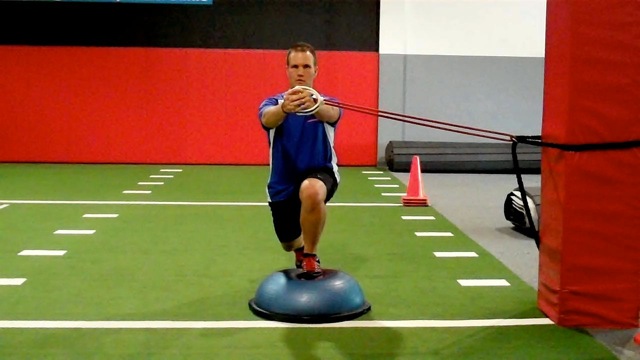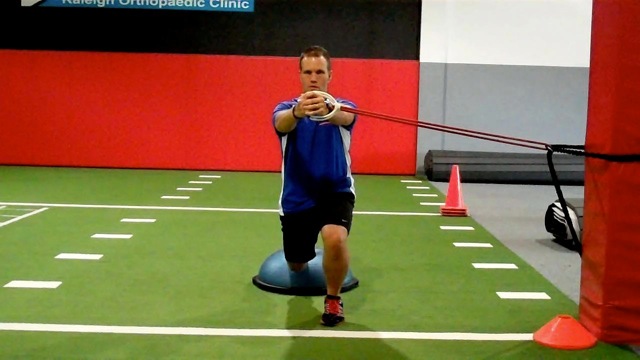
Execution:
|
|
|
|
Application:
This exercise is one of my favorite waysto challenge the hips and core in terms of anti-rotation strengthening andstability. It may appear easy, but you will find mastering form is paramount,and this becomes tricky with increasing resistance, not to mention the inherentcore weakness and limited endurance many clients will have.
Keep in mind that this exercise has many regressions andprogressions as well. It will always be easier in most cases for people whenthe lead leg is on the BOSU because their ground contact will be more stableand less elevated with the rear foot. This will give them a sense of greatersupport as they will not be able to correct movement through visual feedback ofthe trail leg (good proprioceptive training).
Additionally, clients will face a greater challenge when thelead leg inner thigh faces the tubing anchor as this forces them to activatethe hip abductors and small rotators as opposed to the large adductor musclegroup to maintain control. So keep this in mind when selecting resistance levelor coaching/cueing the exercise.
In my practice and experience, I include this particularexercise with all different types of clientele, ranging from youth athletes allthe way up to active aging adults. If your client is not ready to incorporatethe BOSU, begin on flat ground first. Below is a sample list of steps andphases to take a client through using this activity:
Level 1
1.Lead leg on BOSU (outer thigh facing tubinganchor) with hands against the chest
2.Lead leg on BOSU (inner thigh facing tubinganchor) with hands against the chest
3.Trail leg on BOSU (front outer thigh facingtubing anchor) with hands against the chest
4.Trail leg on BOSU (front inner thigh facingtubing anchor) with hands against the chest
Note: Performing this sequence just once would provide four(30) second exercises with the BOSU under the front foot and four more with itunder the rear foot.
Level 2
Repeat the same cycle only extend the arms fully asdescribed in the beginning. Once the clients master this, have them slowlypulse the tubing for some added rhythmic stabilization.
Level 3
This stage allows you to get involved and adds someexcitement to the drill. Follow the same progressions, but now the trainerrandomly pulls on the tubing to create unpredictable perturbations while theclient attempts to maintain alignment.
Begin with the hands in and move out as the client is ableto. I suggest pulling from the same anchor point initially, and then pullingthe tubing in different plane of movement throughout the 30 second time frameto maximize the stimulus and difficulty. The goal in this stage is totemporarily disrupt the client more so than to cause poor form and/or failure.
Brian Schiff, PT, CSCS, is a licensed physical therapist, respected author and fitness professional. Currently, he serves as the supervisor at the Athletic Performance Center in Raleigh, NC. Brian presents nationally at several professional conferences and seminars on injury prevention, rehab and sport-specific training. For more cutting edge training information, subscribe to his monthly Training & Sports Medicine Update at www.BrianSchiff.com.

 Affix elastic tubing with handles around a stationary object. Grab the handle of the free end of tubing and move far enough away to generate moderate resistance. Next, place the front or lead leg on the BOSU and assume the split squat position. Then extend the arms straight away from the body and hold the handle at shoulder height against the resistance. Hold for 30 seconds, maintaining good alignment throughout the entire body as the trunk may tend to sway or the hips and knees may not stay in the sagittal plane.
Affix elastic tubing with handles around a stationary object. Grab the handle of the free end of tubing and move far enough away to generate moderate resistance. Next, place the front or lead leg on the BOSU and assume the split squat position. Then extend the arms straight away from the body and hold the handle at shoulder height against the resistance. Hold for 30 seconds, maintaining good alignment throughout the entire body as the trunk may tend to sway or the hips and knees may not stay in the sagittal plane. Switch lead legs and repeat. Then rotate 180 degrees so you can complete the same sequence with the line of pull coming from the other side of the front leg. After this is completed, move the BOSU so that the trail foot is now positioned on it and repeat the same technique and pattern for 30 seconds on each side. Be sure to use as much resistance as possible without losing form. It should be challenging during the last 10 seconds to maintain control.
Switch lead legs and repeat. Then rotate 180 degrees so you can complete the same sequence with the line of pull coming from the other side of the front leg. After this is completed, move the BOSU so that the trail foot is now positioned on it and repeat the same technique and pattern for 30 seconds on each side. Be sure to use as much resistance as possible without losing form. It should be challenging during the last 10 seconds to maintain control.
















